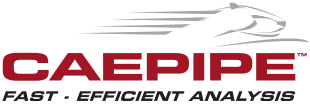CAEPIPE (kay•pipe), the 1st pipe stress analysis software on PC (1983), continues to be the preferred tool for static and dynamic stress analysis of piping systems of any complexity in any industry. Its no-nonsense, rapid “get-it-done” user interface lets you interactively and iteratively design and analyze your piping system for optimum configuration in the shortest possible time.
Download a Free Copy of the latest version and See for Yourself or Contact Us for a Live Demonstration.
Everything You Need, Nothing You Don’t
Statics
Dynamics
Built–In Libraries
Code Compliance
- Multiple temperatures (10)
- Weight and multiple pressures (10)
- Thermal anchor movements
- External forces and moments
- Non-repeated anchor movements
- Nonlinear – gaps, friction
- 95+ Load Combinations
- Multiple Wind loads (4)
- Force spectra
- Harmonic loads
- Time history loads
- Seismic response spectra
- Static seismic acceleration
- Natural Frequencies, and more.
- Valves
- Flanges
- Insulation
- 500 Pipe Materials
- Structural members - AISC
- Pipe sizes - ISO, ANSI, DIN, JIS
- Automatic Spring Hanger Design
(35 hanger catalogs built-in)
- ANSI B31 (latest)
- ASME Class 2
- EN 13480-3
- Swedish
- API
- NEMA
- French, and more
Structural
FRP Piping
Buried Piping
Jacketed Piping
- Model structures along with piping in the same model
- Model FRP piping along with isotropic material piping
- Model FRP/steel piping buried in soil
- Model separate material, temperature and pressure for core and jacket
See CAEPIPE in Action

4:09

7:00

3:05

10:34
What CAEPIPE Users Have Been Saying
Using CAEPIPE to model the structure cut the engineering time from weeks to days, eliminated the high cost and lead time associated with FEA, and provided a “close enough” design for the estimating department to use.
Andrew Springer, PE, Senior Mechanical Engineer, Ershigs, WA, USA
I have been a user of CAEPIPE for 3+ years in Washington and British Columbia. I found CAEPIPE to be more flexible, nimbler, and way user-friendlier than another leading program......in terms of modeling speed, ease of checking, and a more stable platform for repeatable results.
Ray Alvarado, P.E. Mechanical Piping Engineer, PSN World Calgary
We use CAEPIPE to design the process coils in our steam cracking furnaces. These coils operate at temperatures between 1,200°F & 2,000°F. Supports must be sized properly to prevent coil distortion and rapid failure. CAEPIPE graphic displays are extremely useful in determining if we have input the geometry correctly and in evaluation of results.
Arthur DiNicolantonio, Major Oil Company
CAEPIPE user for over 17 years
[CAEPIPE] is a very practical and efficient engineering tool, and I would like to take this opportunity to thank you for your help and technical support... Analysis is fast and consistent. I enjoy using CAEPIPE.
Blazo Ljubicic, Research Engineer, EERC, Grand Forks, ND - CAEPIPE user for over 15 years
CAEPIPE's features permit quick model modifications and subsequent analysis and results review. This allows the user to perform "what if" scenarios quickly and easily.
Les Larson, Basic Electric Power CoOp
CAEPIPE user for over 25 years
The ability to model quickly and perform quick iterations saves the client money and allows for a more readily optimized solution that everyone involved is more pleased with, in the long run.
Marcus Casserd, Anvil Corp.
CAEPIPE user for over 25 years
The new graphics rendering feature in CAEPIPE is fantastic. It far exceeds the graphics of any other piping stress analysis program I have seen.
Ed Patnode, Advanced Thermal
CAEPIPE user for over 15 years
I licensed CAEPIPE for its user-friendliness and flexibility ... in CAEPIPE, I can model twice as fast.
Kyle Schmidt, Fiberglass Structural Engrg.
CAEPIPE user for over 12 years
I ran through the complete model tutorial on the web's online trial version. It [CAEPIPE] was one of the best trial versions I have ever seen, including any and all other types of different tutorials I've tried in the past.
Gary T., Daview Engrg. LA
Download a Free Copy
- 32 or 64-bit Processor
- XP / Vista / Windows 7 / Windows 8 / Windows 8.1 / Windows 10
- Use Parallels or similar to load a Windows environment so you can run any Windows-compatible software.
- Use Wine or any other Windows emulator.
